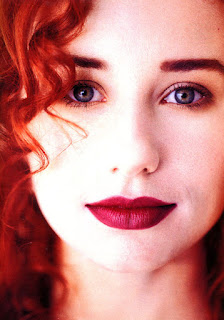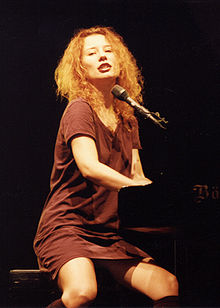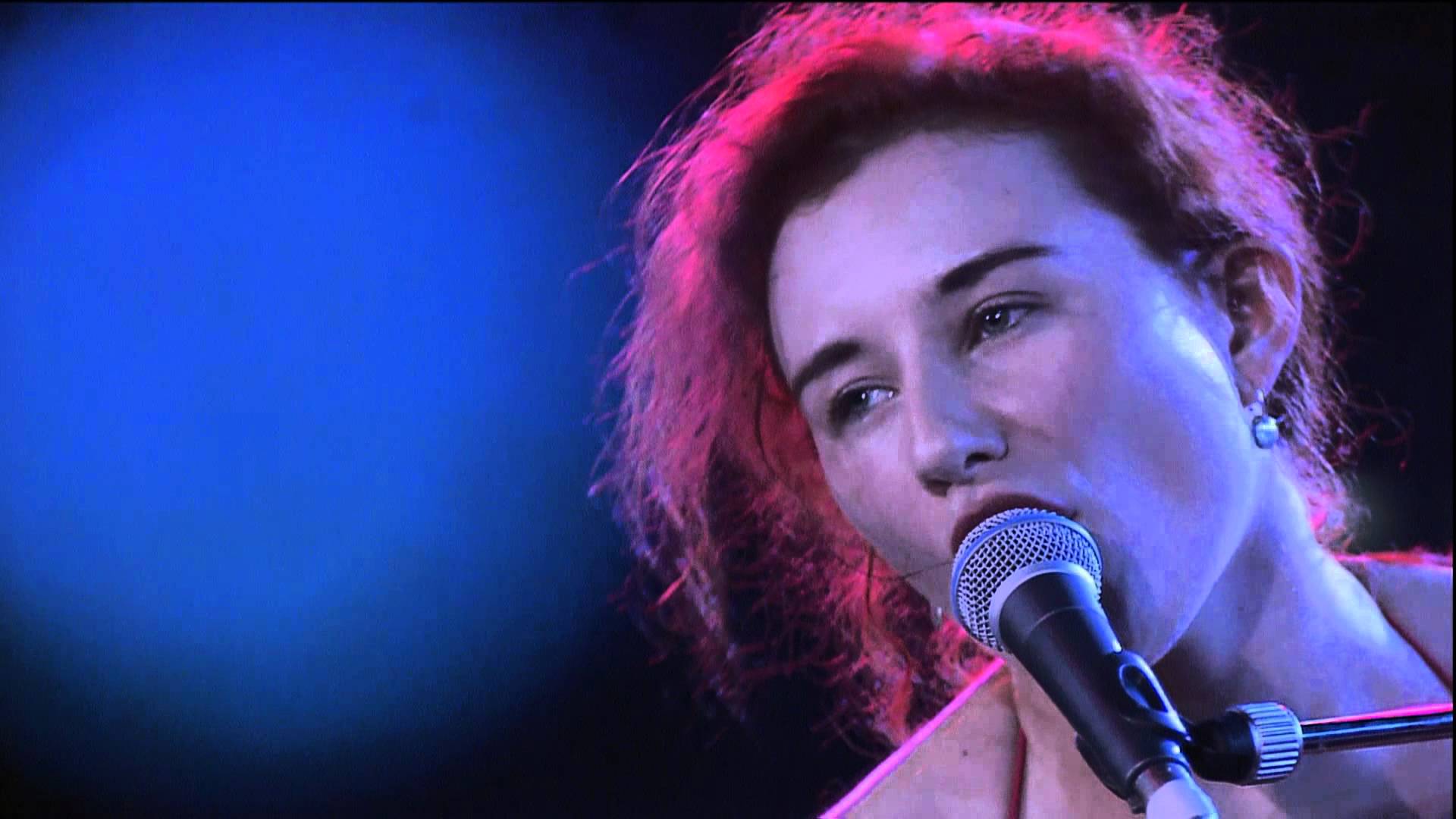Tori Amos (born
Myra Ellen Amos,
[1] August 22, 1963
[2]) is
mezzo-soprano vocal range.
[10]
an American singer-songwriter, pianist and composer. She is a classically trained musician with a
mezzo-soprano vocal range.

Having already begun composing instrumental pieces on piano, Amos won a full scholarship to the
Peabody Institute
at Johns Hopkins University at the age of five, the youngest person
ever to have been admitted. She was expelled at the age of eleven for
what
Rolling Stone described as "musical insubordination."
[11] Amos was the lead singer of the short-lived 1980s
pop group
Y Kant Tori Read
before achieving her breakthrough as a solo artist in the early 1990s.
Her songs focus on a broad range of topics, including sexuality,
feminism, politics, and religion.
[12]

Her charting singles include "
Crucify", "
Silent All These Years", "
God", "
Cornflake Girl", "
Caught a Lite Sneeze", "
Professional Widow", "
Spark", "
1000 Oceans", "
Flavor", and "
A Sorta Fairytale", her most commercially successful single in the U.S. to date.
[13] Amos has received five
MTV VMA nominations, eight
Grammy nominations, and has won an
Echo award for her classical work. She is listed on
VH1's "100 Greatest Women of Rock and Roll" list.
Early life and education
Amos is the third child of Mary Ellen (Copeland) and the Rev. Edison McKinley Amos.
[15] She was born at the Old Catawba Hospital in
Newton, North Carolina during a trip from their
Georgetown home in Washington, D.C. Amos has said that her maternal grandparents each had an
Eastern Cherokee
grandparent of their own; of particular importance to her as a child
was her maternal grandfather, Calvin Clinton Copeland, who was a great
source of inspiration and guidance, offering a more
pantheistic spiritual alternative to her father and paternal grandmother's traditional Christianity.

When she was two years old, her family moved to
Baltimore, Maryland,
where her father had transplanted his Methodist ministry from its
original base in Washington, D.C. Her older brother and sister took
piano lessons, but Amos didn't need them. From the time she could reach
the piano, she taught herself to play: when she was two, she could
reproduce pieces of music she had only heard once,
[17]
and, by the age of three, she was composing her own songs. She has
described seeing music as structures of light since early childhood, an
experience consistent with
chromesthesia:
The song appears as light filament once I've cracked it. As long as
I've been doing this, which is more than thirty-five years, I've never
seen the same light creature in my life. Obviously similar chord
progressions follow similar light patterns, but try to imagine the best
kaleidoscope ever—after the initial excitement, you start to focus on
each element's stunning original detail. For instance, the sound of the
words with the sound of the chord progression combined with the rhythm
manifests itself in a unique expression of the architecture of
color-and-light. ... I started visiting this world when I was three,
listening to a piece by Béla Bartók; I visited a configuration that day
that wasn't on this earth. ... It was euphoric.
At five, she became the youngest student ever admitted to the preparatory division of the
Peabody Conservatory of Music.
[20] She studied classical piano at Peabody from 1968 to 1974.
In 1974, when she was 11, her scholarship was discontinued and she was
asked to leave. Amos has asserted that she lost the scholarship because
of her interest in
rock and popular music, coupled with her dislike for reading from sheet music.
[17][22]
In 1972, the Amos family moved to
Silver Spring, Maryland, where her father became pastor of the Good Shepherd United Methodist church. At 13, Amos began playing at
gay bars and
piano bars, chaperoned by her father.
[17]
Amos won a county teen talent contest in 1977, singing a song called "More Than Just a Friend".
[20] As a senior at
Richard Montgomery High School, she co-wrote "
Baltimore" with her brother Mike Amos for a competition involving the
Baltimore Orioles. The song won the contest and became her first single, released as a
7" single pressed locally for family and friends during 1980 with another Amos-penned composition as a
B-side,
"Walking With You". Before this, she had performed under her middle
name, Ellen, but permanently adopted Tori after a friend's boyfriend
told her she looked like a
Torrey pine, a tree native to the West Coast.
[24]
 Career
Career
Beginnings
By
the time she was 17, Amos had a stock of homemade demo tapes that her
father regularly sent out to record companies and producers.
[20] Producer
Narada Michael Walden responded favorably: he and Amos cut some tracks together, but none were released.
[20] Eventually,
Atlantic Records responded to one of the tapes, and, when
A&R man
Jason Flom flew to Baltimore to audition her in person, the label was convinced and signed her.
In 1984, Amos moved to Los Angeles to pursue her music career
[20] after several years performing on the piano bar circuit of the
D.C. area.
Y Kant Tori Read (1986–88)
In 1986, Amos formed a musical group called
Y Kant Tori Read, named for her difficulty
sight reading.
[25] In addition to Amos, the group was composed of
Steve Caton (who would later play guitars on all of her albums until 1999), drummer
Matt Sorum,
bass player Brad Cobb and, for a short time, keyboardist Jim Tauber.
The band went through several iterations of songwriting and recording;
Amos has said interference from record executives caused the band to
lose its musical edge and direction during this time. Finally, in July
1988, the band's self-titled debut album,
Y Kant Tori Read, was released. Although its producer,
Joe Chiccarelli, stated that Amos was very happy with the album at the time,
[26] Amos has since criticized it, once remarking: "The only good thing about that album is my ankle high boots."
[27]
Following the album's commercial failure and the group's subsequent
disbanding, Amos began working with other artists (including
Stan Ridgway,
Sandra Bernhard, and
Al Stewart) as a backup vocalist. She also recorded a song called "Distant Storm" for the film
China O'Brien; in the credits, the song is attributed to a band called Tess Makes Good.
[28]
The Atlantic years (1990–2001)
Despite the disappointing reaction to
Y Kant Tori Read,
Amos still had to comply with her six-record contract with Atlantic
Records, which, in 1989, wanted a new record by March 1990. The initial
recordings were declined by the label, which Amos felt was because the
album had not been properly presented.
[29] The album was reworked and expanded under the guidance of
Doug Morris and the musical talents of
Steve Caton,
Eric Rosse, Will MacGregor, Carlo Nuccio, and Dan Nebenzal, resulting in
Little Earthquakes, an album recounting her religious upbringing, sexual awakening, struggle to establish her identity, and sexual assault. This album became her commercial and artistic breakthrough, entering the British charts in January 1992 at Number 15.
Little Earthquakes
was released in the United States in February 1992 and slowly but
steadily began to attract listeners, gaining more attention with the
video for the single "
Silent All These Years".
Amos traveled to
New Mexico with personal and professional partner
Eric Rosse in 1993 to write and largely record her second solo record,
Under the Pink. The album was received with mostly favorable reviews and sold enough copies to chart at No. 12 on the
Billboard 200,
[30] a significantly higher position than the preceding album's position at No. 54 on the same chart.
[31] However, the album found its biggest success in the UK, debuting at number one upon release in February 1994.

Her third solo album,
Boys for Pele, was released in January 1996. The album was recorded in an Irish church, in
Delgany,
County Wicklow, with Amos taking advantage of the church's acoustics. For this album, Amos used
harpsichord,
harmonium, and
clavichord
as well as the piano. The album garnered mixed reviews upon its
release, with some critics praising its intensity and uniqueness while
others bemoaned its comparative impenetrability. Despite the album's
erratic lyrical content and instrumentation, the latter of which kept it
away from mainstream audiences,
Boys for Pele is Amos's most successful simultaneous transatlantic release, reaching No. 2 on the UK Top 40
[32] and No. 2 on the Billboard 200 upon its release.
[30]
Fueled by the desire to have her own recording studio to distance
herself from record company executives, Amos had the barn of her home in
Cornwall converted into the state-of-the-art recording studio, Martian Engineering Studios.
[33]
From the Choirgirl Hotel and
To Venus and Back,
released in May 1998 and September 1999, respectively, differ greatly
from previous albums as Amos's trademark acoustic piano-based sound is
largely replaced with arrangements that include elements of
electronica,
dance music, and vocal washes. The underlying themes of both albums
deal with womanhood and Amos's own miscarriages and marriage. Reviews
for
From the Choirgirl Hotel were mostly favorable and praised Amos's continued artistic originality. Debut sales for
From the Choirgirl Hotel are Amos's best to date, selling 153,000 copies in its first week.
[34] To Venus and Back,
a two-disc release of original studio material and live material
recorded from the previous world tour, received mostly positive reviews
and included the first major-label single available for sale as a
digital download.
[35]
Shortly after giving birth to her daughter, Amos decided to record a
cover album, taking songs written by men about women and reversing the
gender roles to reflect a woman's perspective.
[36] That became
Strange Little Girls, released in September 2001. The album is Amos's first
concept album, with artwork featuring Amos photographed in character of the women portrayed in each song.
Amos would later reveal that a stimulus for the album was to end her
contract with Atlantic without giving them original songs; Amos felt
that since 1998, the label had not been properly promoting her and had
trapped her in a contract by refusing to sell her to another label.
 Born and brought up in Belfast,
Best began his club career in England with Manchester United, with the
scout who had spotted his talent at the age of 15 sending a telegram to
manager Matt Busby which read: "I think I've found you a genius."[3] After making his debut aged 17, he scored 179 goals from 470 appearances over 11 years, and was the club's top goalscorer in the league for five consecutive seasons.[4]
Born and brought up in Belfast,
Best began his club career in England with Manchester United, with the
scout who had spotted his talent at the age of 15 sending a telegram to
manager Matt Busby which read: "I think I've found you a genius."[3] After making his debut aged 17, he scored 179 goals from 470 appearances over 11 years, and was the club's top goalscorer in the league for five consecutive seasons.[4]




